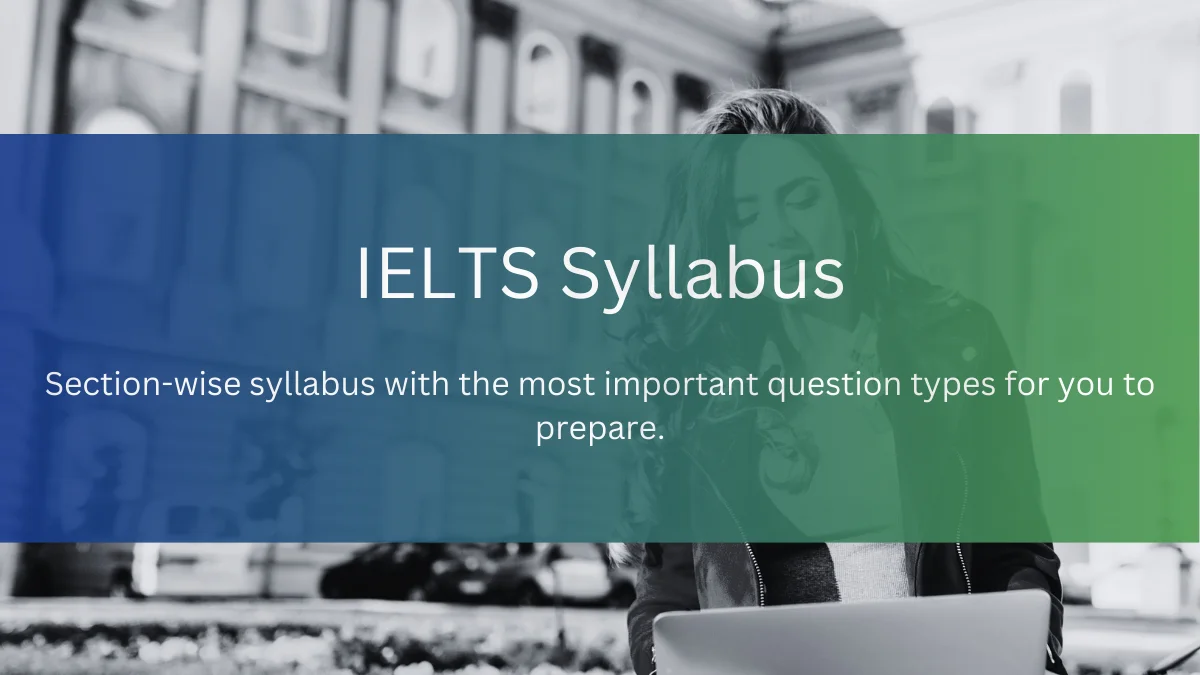Understanding the IELTS Syllabus 2024: Sections-Wise IELTS Exam Syllabus
Understanding the IELTS exam syllabus is essential for you to achieve high scores on the exam. The IELTS exam has two versions, namely, Academic and General Training. Academic is for those who wish to pursue higher education in an English-speaking country. General Training is for those who want to work or migrate to such countries. As of 2024, the IELTS syllabus maintains its structure, comprising four distinct sections: writing, reading, listening, and speaking. Each section poses unique challenges and demands a comprehensive understanding of the English language.

Below is the IELTS syllabus in detail:
| Test Component | Academic IELTS | General Training IELTS | Time Allotted |
| Listening | 4 Sections, 40 Questions |
4 sections, 40 questions |
30 Minutes |
| Reading | 3 Passages, 40 Questions |
Multiple texts, 40 questions |
30 Minutes |
| Writing | Task 1: Describe data;
Task 2: Essay |
Task 1: Write a letter; |
60 Minutes |
| Speaking | Part 1: Background; Part 2: Topic; Part 3: Discussion | Part 1: Background;
Part 2: Topic; Part 3: Discussion |
11- 14 Minutes |
IELTS Syllabus 2024 (Sections Wise) – Listening, Speaking, Reading, Writing
Writing Syllabus
The IELTS Writing section, the first section of the IELTS examination journey, contains two tasks designed to evaluate candidates’ ability to express themselves effectively in the written format.
Read More – How to Score Band 8 in IELTS?
IELTS Academic Writing:
- Task 1: This involves interpreting and analyzing graphical representations, such as charts, diagrams, or tables, and presenting a concise summary of the information within a 150-word essay.
- Task 2: This requires candidates to articulate their points of view, arguments, or suggestions on any given topic in a 250-word essay.
ELTS General Training Writing:
- Task 1: Necessitates responding to a given situation by composing a formal or semi-formal letter.
- Task 2: This task involves an essay based on the viewpoint expressed in the preceding letter, allowing for a semi-personal or personal tone.
Read More – How Hard is IELTS?
Types of Questions in the Writing Section:
- Agree/disagree: Candidates must write their agreement or disagreement with a given statement and give supporting arguments or opinions.
- Advantages/disadvantages: Candidates have to discuss the advantages and disadvantages of a particular situation.
- Cause/solution: Candidates have to analyse the causes of a problem and propose potential solutions to the given question.
- Two-part questions: Candidates have to respond to two related questions, addressing each part comprehensively.
- Discuss both sides of a question: Candidates write about arguments for and against a topic before expressing their opinion.
Reading Section
The reading IELTS syllabus of the IELTS examination requires candidates to read three passages. From books, journals, magazines, and newspapers, challenging them to comprehend, analyse, and interpret information across various genres.
Read More – The Best IELTS Reading Strategies Ever!
IELTS Academic Reading:
This section consists of three lengthy paragraphs drawn from academic sources. For example books, journals, and articles, catering to the comprehension skills of postgraduate and professional students.
IELTS General Training Reading:
IELTS General Training Reading section mirrors the format of the academic module but features topics relevant to everyday life, including pamphlets, advertisements, and brochures, offering a slightly more manageable challenge.
Read More – Top Colleges Accepting IELTS Scores
Types of Questions in the Reading Section:
- Multiple Choice Questions: Candidates can select the most appropriate answer from a list of options.
- Short-answer questions: Candidates have to read the brief responses to questions based on information from the text.
- Matching information: Candidates have to match specific pieces of information or paragraphs with corresponding sections of the text.
- Matching headings: Candidates have to match paragraph headings with the relevant sections of the text.
- Matching features: Candidates have to match features or characteristics with the appropriate categories.
- Identifying information: Candidates have to locate specific details or information within the text.
- Identifying the writer’s views: Candidates determine the writer’s perspective or opinion on a given topic.
- Sentence completion: Candidates have to complete sentences using information from the paragraph or text.
- Matching Sentence Endings: Candidates have to match sentence endings with the appropriate beginnings.
- Diagram label completion: Candidates have to label diagrams or charts based on information provided in the text.
- Summary, note, table, and flowchart completion: Candidates have to complete summaries, notes, tables, or flowcharts using information from the text.
Read More – IELTS Registration Fees – How much do you need to pay to take the IELTS test in India?
Listening Section
The listening IETS syllabus of the IELTS examination assesses the candidates’ ability to comprehend spoken English across various contexts and scenarios. Four recordings, comprising social, environmental, and educational themes, each lasting three minutes, are played, followed by 40 questions, encompassing note completion, multiple-choice, and sentence completion formats.
Types of Questions in the Listening Section:
- Multiple Choice Questions: Candidates have to select the correct answer from a list of options based on the information given in the recording.
- Sentence completion: Candidates have to complete sentences or phrases using the information heard in the recording.
- Matching: Candidates have to match information or categories with corresponding options presented in the recording.
- Plan, map, and diagram labeling: Candidates have to label plans, maps, or diagrams based on information provided in the recording.
- Table, flowchart, summary completion: Candidates have to complete tables, flowcharts, or summaries using information presented in the recording.
Speaking Section
The speaking examination, serving as the final section, evaluates candidates’ oral communication skills and fluency in English.
Speaking section is divided into three parts:
- Part 1: Self-introduction and discussion on general topics.
- Part 2: Speaking on a given topic for two minutes, followed by a brief question-answer session.
- Part 3: Speaking about abstract and serious issues through a lengthy discussion.
Types of Questions in the Speaking Section
- Part 1- General topics and self-introduction: Candidates respond to questions about their personal experiences, opinions, and preferences, demonstrating their ability to engage in spontaneous conversation.
- Part 2- Speaking on a given topic for two minutes: Candidates deliver a monologue on a specific topic, showcasing their ability to organise their thoughts, use relevant vocabulary, and maintain coherence and fluency.
- Part 3: Discussion on serious issues and topics: Candidates engage in a more complex and nuanced discussion with the examiner, exploring abstract ideas, societal issues, and cultural phenomena, demonstrating their ability to express opinions, analyze perspectives, and engage in meaningful discourse.
You can also read IELTS Preparation Tips 2024 – Reading, Listening, Writing, Speaking for more information.
In conclusion, the IELTS examination is for individuals aspiring to pursue opportunities in English-speaking countries. To master IELTS, you must consistently practice each section with clear comprehension and versatility to achieve a good score. Understanding the IELTS syllabus comprehensively will enable candidates to approach the test with confidence and clarity, which is why you can fill out this form if you would like to improve your knowledge and obtain a more accurate syllabus.: https://docs.google.com/forms/d/e/1FAIpQLScy5XrQ9GnftawXDT7RIpjGnUZOWAqhBh4ATrezKJjtKJ_8iQ/viewform
Where you can get the complete IELTS syllabus, guide & coaching.






